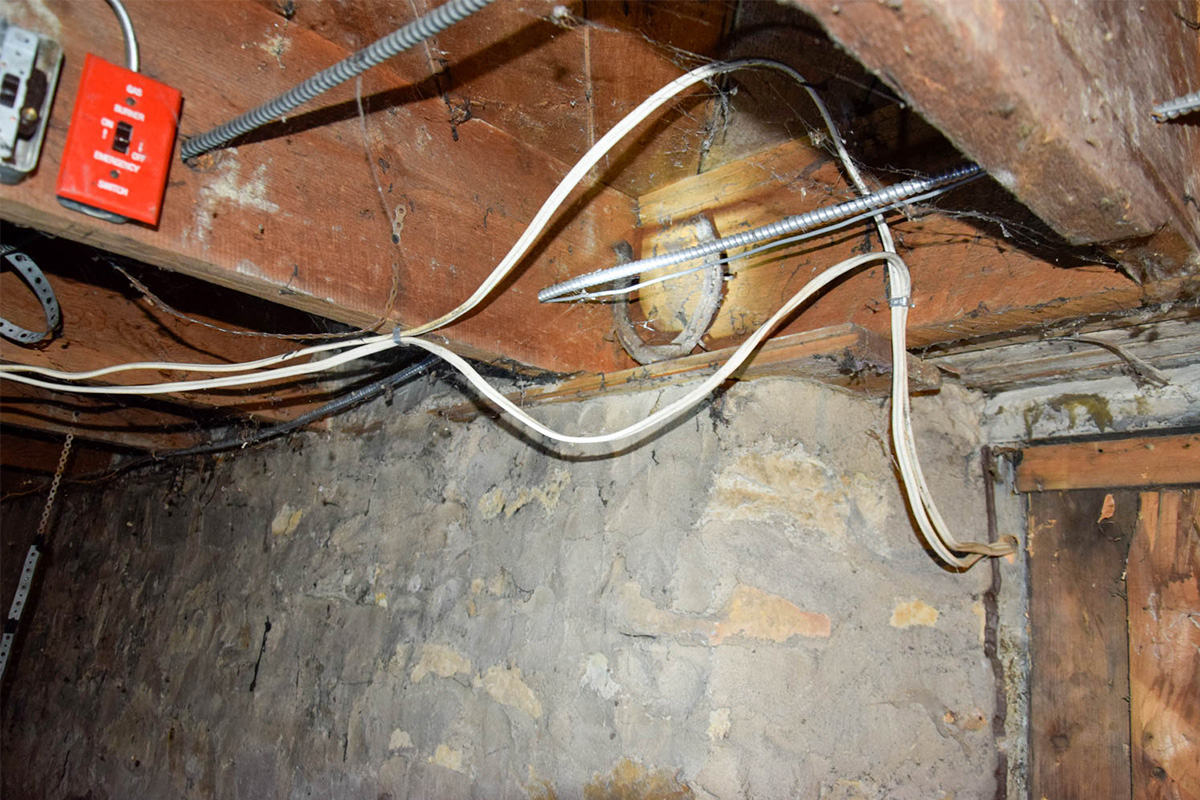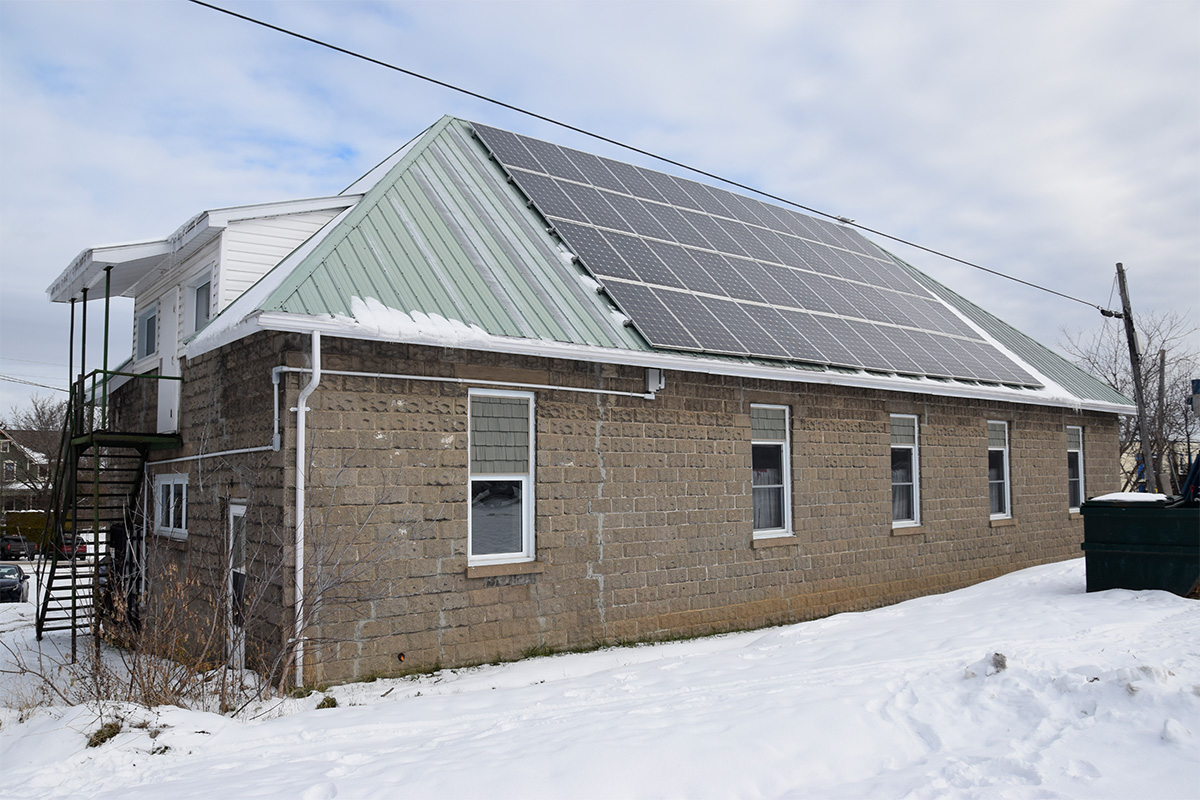LITTLE CURRENT—When it comes to being ahead of the global climate change curve and the need to get off of fossil fuels, Little Current United Church has long been ahead of the curve. The church is now about halfway through its solar power contract with Hydro One, the cells being installed in the spring of 2011, but was still locked into oil heating. The church has now bid adieu to oil with the installation of two heat pumps, one of which will heat the main church, while the second will provide heat for the hall.
The Expositor sat down with church members Scott Mosher and Ivan Edwards to chat about the process and where the church finds itself in the heating mix today. Although the heat pumps have allowed the church to retire its massive oil furnace, there is still a small tether to fossil fuel in the form of propane.
“We went through some fits and starts,” said Mr. Mosher of the multi-year process of changing over the heat plant. “In terms of the project and in terms of supplemental heat, because we know that the heat pumps will extract energy out of the air until -10°C to -20°C, so we had to have some backup here and initially one of the guys was proposing electric induct heaters.”

That presented significant financial challenges, he noted. “That was going to require us to go from a 200-amp service to a 400-amp service, not three phase but necessitating new power lines into the church.”
“The cost just went through the roof for the electrical side of this thing and we thought we just can’t afford to do this,” said Mr. Mosher. “So then, on a positive note, one of the vendors we were dealing with came back and said, ‘I have a different solution for you.’ He said rather than have electric in-duct heaters, we install in hot water in-duct heaters. When we first read this, the mistake I made was I thought, ‘okay, it’ll be electric hot water.’ But no, it’s propane. So, if you look, we’ve got two small propane tanks on the other side of the church. We’ve got an on-demand boiler downstairs in the basement that works to provide in-duct hot water heaters which will provide the energy input to keep the temperature up.”
“So, our kitchen now is also propane,” said Mr. Edwards.
The basement of the church is much like what one would expect of a building whose construction began as a Methodist Church back in 1881, completed in 1882. The foundations, in fact, the entire original church building, was constructed from locally quarried limestone and measured 60 feet by 40 feet. That original building was destroyed by fire, but work began quickly to rebuild it in a more robust form that has lasted to the present day—albeit not entirely successfully, as the building again burnt in 1929. The walls were then restrengthened, with a foyer and balcony being added.

Over the years, renovations and minor additions continued to be made—including a steel roof in 1993.
“The foundations are a throwback to when the place was built,” said Mr. Mosher, who noted the hall portion of the current church was built in 1923. “So, those foundations have been around for a long, long time.”
The basement provided an interesting bit of history during the assessment and planning for the new heat plant.
“When I was downstairs looking around, I saw a horseshoe tucked up in one of the floor joists,” recalled Mr. Mosher. “And I thought like, ‘how did that get there? Who put it there?’”
Mr. Mosher investigated the history of placing horeshoes under the foundations of new construction, sharing what he learned with Mr. Edwards and pastor Reverend Whitney Bruno.
“What’s really interesting is, with respect to the old tradition, there was Bishop Saint Dunstan back in 969 AD who apparently became the Archbishop of Canterbury and who’d been a blacksmith before entering the church,” said Mr. Mosher. “The way the story goes, St. Dunstan tricked the devil by shoeing him (the devil being depicted as a hooved creature in the medieval period).”

But the devil apparently didn’t care for being iron shod (iron was believed to be imbued with magical power against the fae and the devil’s minions), “so he took the horseshoe away and since then the horseshoe has provided good luck.” According to legend, the devil cannot enter a home that contains a horseshoe over its threshold. Further, horseshoes have seven holes with which nails fasten it to a hoof—and seven has long been viewed as a lucky number and the early Chaldean Christians believed its crescent shape protected against the curse of the evil eye.
“There’s probably some kernel of truth associated with it,” said Mr. Mosher.
“I would like to know who the devil it was he shoed,” laughed Mr. Edwards.

“We took the vendors downstairs and they looked at our old oil-fired furnaces,” said Mr. Mosher. “They copied down the sizes and just duplicated that.”
There were some necessary changes as to how the church would be heated, however. “We used to cycle the temperatures, when the facility was not used and the temperature was taken down to like 12° Celsius and when it was in use, we cranked it up to 18° Celsius. And now, because the heat pumps can’t handle that, they like to stay in a very tight range, we’ve got it set right now at about 20° Celsius.”
As a bonus, the new heat pump system also provides air conditioning.

Although the church does not tend to get too hot in the summer, humidity is a big issue.
Funding for the changeover came largely from the United Church of Canada through one of their programs, but there were also local donations—including some sizable ones. “Even somebody that doesn’t go to our church heard about us putting in the heat pumps and gave us a very generous donation as well.”
Funding also came from the Little Current Lions Club Catch the Ace lottery as the church’s hall is deemed a useful community venue.





